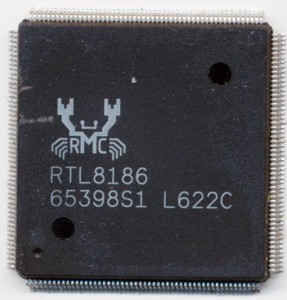Realtek RTL8186: MIPS by Lexra
The MIPS architecture was created in 1985 from a project at Stanford University. It was one of the first licenseable architectures. A company could buy a license and make their own MIPS architecture processors. By the 1990’s this had become fairly common and many companies were making MIPS processors, including Performance Semiconductor, IDT, NEC, Toshiba, LSI and more. In 1992 MIPS Computer Systems, Inc. was bought by SGI, in order to guarantee a supply a continued development of new MIPS designs for SGIs computers. It did continue to license the design to other companies as well, fostering competition which helped lower prices for SGI. In 1998 SGI spun off MIPS into its own company once again, as SGI at the time had decided to move towards Intel’s Itanium architecture (this should sound familiar, DEC and the Alpha suffered the same fate). By 2008 MIPS was losing money and in 2013 what little remained (having used most of their cash to buy, and then sell at a loss Chipidea) of them was bought by Imagination Technologies (makers of the PowerVR line of graphic solutions, used notably in the Apple iPhone’s A4, A5, A6, and likely A7 processors). But there is a bit more to the story of MIPS, a seemingly small chapter that very well could have changed history and certainly changed the success of MIPS.
In 1997 a small company called Lexra was started. Lexra was a semiconductor Intellectual Property company. They designed processors and licensed the designs. What made Lexra different is that they designed and licensed soft-cores. A soft core is an RTL (Register Transfer Level) model of the processor. It is usually written and delivered in an HDL (Hardware Descriptive Language) such as Verilog or VHDL and the purchaser may compile it down to whatever actual transistor level hardware they like. This is exactly how ARM works today, but in 1997 ARM only licensed hard cores, cores already compiled down to the gate level and ready for implementation on a given fab process technology. This allowed them to have tighter control over the design and its performance, but made integration much harder into other products. A soft core like Lexra designed enabled rapid integration into a variety of SoCs and other applications. Lexra’s chosen architecture was MIPS and that is where the story gets interesting.
Lexra’s MIPS cores were not licensed from MIPS, nor did they need to be, they merely implemented the MIPS instruction set, not copied the MIPS transistor level designs. When MIPS was spun out of SGI in 1998 one of their first activities was to sue Lexra, Lexra agreed to not market their cores as ‘MIPS Compatible’ and life went on, until MIPS decided to sue again, over a patent (whose validity was in question) on unaligned loads and stores. They ended up settling, paying Lexra $10 million and cross licensing various technologies as well as forcing Lexra to stop licensing its cores and eventually out of business in 2003, just as ARM began to really take the market by storm. More of the Lexra story can be read here on Jonah Probell’s page, who used to work there.
Lexra greatly enhanced the MIPS design, and produced several notable firsts including IP cores with 6 and 7 stage pipelines, MIPS16 (a microcontroller focused version) code compression, DSP extensions, EJTAG support (for debugging and dev work), and multi-threading support (which proved very useful for network processing). In less then 6 years Lexra developed and licensed 9 processor cores, all as soft cores, for easy integration. Lexra’s demise is what ended up making ARM such a wild success. In the late 90’s and early 2000’s there was a bit of a battle between ARM and MIPS for embedded RISC market control. The battle was not won by ARM though, it was lost by MIPS. It would be very interesting to see where MIPS as an architecture would be today had they concentrated on making it readily available as a soft core rather then fighting another member of their ecosystem. As a testament to Lexra’s designs, many are still being used, the Realtek pictured above was in fact made in 2006, 3 years after the demise of Lexra. Realtek, a creative Taiwanese company, assembled its own team of processor core designers and has taken the basic Lexra core and improved it themselves. The architecture and instruction set is sound, robust and still useful (and used) today but unfortunately corporate politics choked its chances at truly shining, allowing ARM to win by default.


